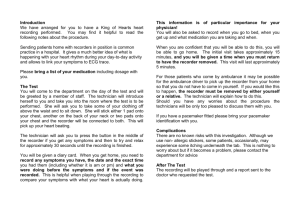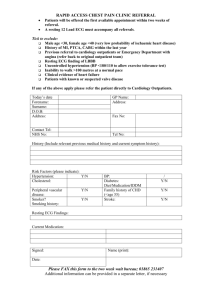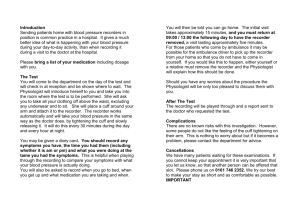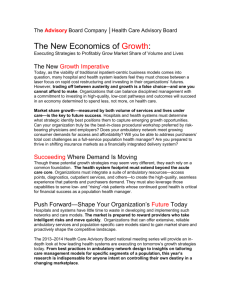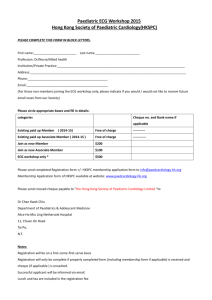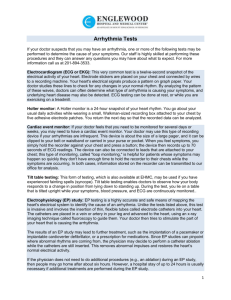CSCT Ambulatory ECG
advertisement
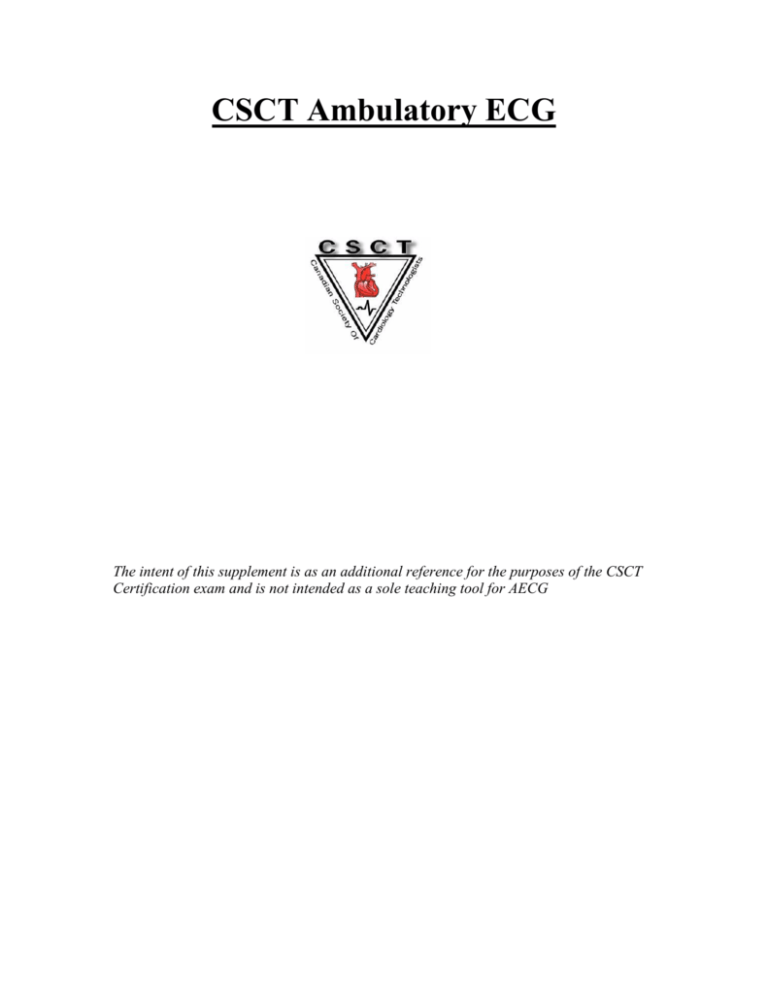
CSCT Ambulatory ECG The intent of this supplement is as an additional reference for the purposes of the CSCT Certification exam and is not intended as a sole teaching tool for AECG Contents Define Ambulatory Monitoring Indications for Ambulatory Monitoring Contraindications for Ambulatory Monitoring Role of the Cardiology Technologist Hookup: quality of recording, minimizing artifact and the patient diary/logbook Disconnect Scanning List the items that should be included on an ambulatory ECG monitor report What is Ambulatory Monitoring An Ambulatory ECG (AECG – commonly known as holter monitoring after its inventor Dr N Holter) is a continuous, twenty four or forty eight hour electrocardiography (ECG) recording of the electrical impulses generated by the heart. The patient wears a recorder for the defined time period and during the recording, keeps a log book outlining all activities, symptoms and medications taken. Following the completion of the recording, the patient returns to the testing facility to have the recorder removed. The data from the recorder is analyzed by a cardiology technologist using proprietary software. A report is then generated and forwarded to a physician for interpretation. Indications for Ambulatory Monitoring The following are indications for AECG as per the ACC/AHA Guidelines for Ambulatory Electrocardiography: Executive Summary and Recommendations: http://circ.ahajournals.org/cgi/content/full/100/8/886 1. Heart rate Variability (HRV) 2. Assessment of symptoms that may be related to disturbances of heart rhythm 3. Assessment of risk in patients without symptoms of arrhythmias a. After myocardial infarction b. Congestive heart failure c. Hypertrophic cardiomyopathy 4. Efficacy of antiarrhythmic therapy 5. Assessment of pacemaker and ICD function 6. Monitoring for myocardial ischemia 7. Pediatric patients Contraindications for Ambulatory Monitoring 1. Intolerance of patients skin to skin prep products and/or electrodes and/or tape used for stress loops 2. Dementia resulting in the patient removing the electrodes prior to the completion of the test Role of the Cardiology Technologist 1. Identify patient and obtain relevant information as per institution protocol 2. Connect the sensors and start recording as per manufacturers instructions 3. Provide patient with instructions as to completing the patient diary/logbook 4. Disconnect recorder at the completion of the test 5. Download data from the recorder as per manufactures instructions 6. Analyze the data and prepare a report for the interpretation by a cardiologist Hookup: Sensor placements are chosen as per the institution protocol and the manufacturer’s instructions. By moving the exploring lead while watching the digital display (if available), the technologist can make the ECG signal as large as possible and any artifact signals as low as possible. Most manufacturers have at least two recording lead which allows for continuous recording even if one lead becomes disconnected during the recording period. The sensors should be placed over bony areas and securely attached to the skin to minimize loss of contact and interference due to muscle tremor. Securing the lead wires with stress loops will also help reduce somatic tremor from obscuring the baseline. Diary/logbook: The patient is asked to keep a diary of all symptoms, activities, and events during the period of AECG monitoring. When carefully recorded and timed correctly the log is valuable in diagnosing the complaint of the patient. Obviously patients should record symptoms such as, palpitations, dyspnea, fatigue,dizziness, chest pain/discomfort, arm pain, nausea, presyncope or syncope Patients are not usually aware of the fact that silent angina shows ischemic ST changes without typical chest pain. Patients should be instructed to record any discomfort, not only chest pain, e.g. pain in the neck, arm, jaw, as soreness, heaviness, pressure, sharp pain and indigestion It is also important that the patient should note the following carefully at the time of occurrence: – Meals – Taking of any stimulants, coffee, chocolate, smoking – Taking medication – Stress such as anger, frustration, sorrow, depression, anxiety – Exercise, sexual activity – Bowel movement, straining and any valsalva maneuvers, heavy lifting and hyperventilation. The diary is also an essential tool to exclude false positive or false negative findings. All diary entries should be shown in AECG strips even if the rhythm is normal. This way the reading physician will be sure that there is nothing significant happening at that time. The patient should provide a list of all cardiac related medication. Disconnect: Upon removing the recorder and sensors, the patients’ skin should be assessed for integrity. Some patients may be allergic or sensitive to the sensors and should be referred to their physician if necessary Prior to releasing the patient, they should be queried for any significant symptoms and their diary reviewed. The data from the recorder is downloaded to the scanning software /analyzer as per manufacturer’s instructions Analysing the data and compiling a report: The purpose of the report is to compile an overview summary of the relation between symptoms or events that the patient may have experienced and possible aberrations in the AECG recording. The AECG is a suitable method to determine if symptoms may be cardiac related. Events such as daily activities or unusual stress could have precipitated or evoked arrhythmias or ischemic episodes. The frequency and seriousness of the AECG aberrations should be evaluated in order to supply the physician with essential information to make a diagnosis and to help decide on appropriate treatment. A huge amount of raw ECG data is acquired during the period of recording and the important task of the cardiology technologist is to process it by scanning, integrating and summarizing the data in such a way that the final report shows the diagnostically important information in a reliable, clinically understandable, easy and quick-to-read format. To do this the cardiology technologist must be able to recognize the diagnostically important features of the AECG recordings and correlate it with the patient’s diary notes on symptoms and events. The cardiology technologist must also be able to validate the accuracy of the proprietary software protocols for data analysis and report generation as baseline wander and artifact may distort morphologies and ST segments The cardiology technologist must relate ECG changes to any cardiac (or other) medications that the patient is taking as well as identifying appropriate and inappropriate functioning of an ICD. Analysing the data and compiling a report:continued While all facilities will have their own standard analyzing/scanning criteria, it is suggested that the following events are documented and included in the report Start and end of recording – this verifies the actual timing of the test Minimum and maximum heart rate Any changes in ST segments that occur All cardiac symptoms that are reported The onset and offset of significant arrhythmic events – this will assist in the determination of the cause of the arrhythmia Longest pauses Examples of each morphology The report written by the technologist should also contain information such as The underlying rhythm and any changes in rhythm that occur Minimum, maximum and average heart rates with attention paid to heart rate variability and adherence to normal circadian rhythm. Correlation of measured number and types of arrhythmias during waking compared to sleep Frequency of ectopic beats A listing of all cardiac symptoms with the times of occurrence and related ECG findings ST changes (if any) Overall quality of the recording The reliability of the tables and histograms relating to artifact/morphologies References ACC/AHA Guidelines for Ambulatory Electrocardiography: Executive Summary and Recommendations: http://circ.ahajournals.org/cgi/content/full/100/8/886
